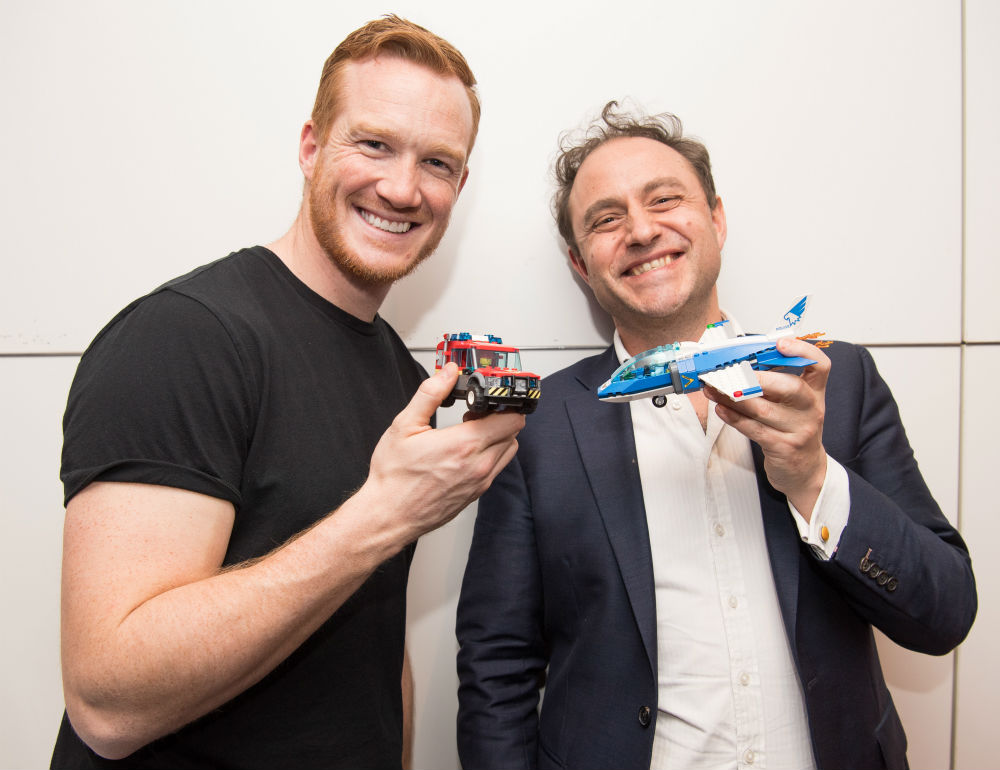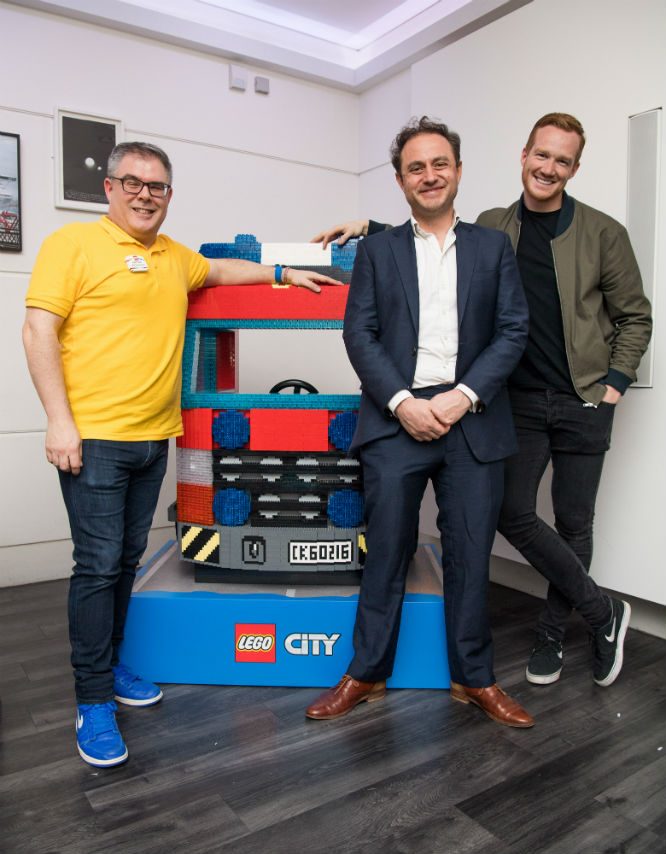Now a recognisable face across the country thanks to his breaking down of the kids' actions on The Secret Life of 4 and 5 Year Olds, Dr. Sam Wass knows what he's talking about when it comes to the minds of little ones! Having teamed up with LEGO on a LEGO City project, aiming to get children thinking about what it means to be an every day hero, we got the chance to put some questions to Dr. Wass all about his career, work with The LEGO Group and more...

What’s a typical day for you Sam?
I’m mainly a research scientist, managing a lab where I have eight staff running different research projects with babies and young children. We are running a few studies looking at brain function in young children, as well as a project in which we attach little microphones and cameras and stress monitors to children to look at how different environments affect childrens' stress levels - and another project in which we look at how emotions are shared between two people - an adult and a child - while they are doing shared activities together. It’s a pretty fun job, that involves lots of different things - running testing sessions with young children, analysing the data that we collect, writing up the results, and then travelling round to present them.
How did you end up appearing on The Secret Life of 4 and 5 Year Olds?
I was first contacted a few years ago, when they were putting together a pilot version of the show. The original concept was that children would be taken one by one into a room, where they would then take part in a series of famous experiments from the history of child psychology - like the ‘marshmallow task’ - and then the same children would be filmed in the nursery, interacting with other children. I was asked to suggest other famous experiments I knew from the history of child psychology that we could use. One thing led to another, and eventually I ended up appearing on-screen.
Tell us about what you’ve been up to with The LEGO Group?
LEGO City is a range of real-life based construction toys that focuses on buildings, vehicles, and scenarios that are familiar to those that children encounter in their everyday life. The key age range is 4-6-year old children.
I have been working with LEGO City, helping to run some research looking at heroism in young children, and their attitudes towards it. As part of this, we asked children what kinds of jobs they want to do when they are grown-ups and we found jobs that would maybe be considered to fall under traditional ‘heroic’ jobs - like being a police officer, or a fire fighter - are losing in popularity. We started a campaign to raise awareness of this - and of the importance of imaginative play in helping children to develop their own ‘inner hero’.
We weren’t trying to get more children to aspire to necessarily be a firefighter or a police officer, but instead start thinking about what kind of traits every day heroes have and encourage the children to start displaying these in the every day – inquisitiveness, teamwork, a sense of right and wrong, being caring and helpful. These skills are essential in all manner of jobs and by getting the children to think about them at a young age we’d then expect to see them displayed more as they develop.
What did you find out from the focus groups?
Children aged 4-6 year olds go through a shift, from thinking about heroes as people who are infinitely powerful, like superheroes, towards appreciating that in fact, in the real world, nobody is infinitely brave, or infinitely strong - and that the people who are brave and strong are people who have worked hard to get there.
Some of the older children we talked to were starting to realise just that - how real-world heroism involved simple things, like making sacrifices for a loved relative - or one little girl who told a story about how she dropped a toy under her bed, and she really wanted to get it back so she reached down under there - even though it’s dark and scary under her bed. She thought that that made her a hero - and we completely agreed!
Is creative play important for a child’s development?
Yes - definitely. Creative play helps children to develop key skills they will need for life. It may look as if children are just bashing together a couple of figurines when they play – but in fact, research suggests that children are thinking themselves into the characters’ perspective while they act out imaginary scenarios. They’re really feeling what the world, and what a particular sequence of events, feels like from their character’s point of view!
So because of this, imaginative play helps children ‘try on’ scenarios in their heads. Although a child might not be ready yet to actually enter a burning building and rescue someone from it, acting out this imaginary scenario during play can be an essential part of imagining what it would feel like if they did it themselves. And this process of imagining it can be an important part of preparing themselves for different situations later in life.
Do you think our actions and playtime as children develop who we are as adults
Yes - to a degree. Having watched a lot of different children playing over the years, I think that children often use play to ’try on’ a variety of different hats, to see which fits. One day they’ll want to see what being a doctor feelslike, another day a teacher, then an athlete and then a police officer. Interestingly, a lot of the children most interested in infinitely powerful superheroes are children who naturally, by themselves, are quite fearful. Creative play gives children a safe environment to try and learn more about the world.
Will there be another series of The Secret Life of 4 and 5 Year Olds?
We don’t know yet - we’re waiting to hear!
Why do you think the show is so popular?
I think that there are lots of reasons. One of the things that we always go for is to look for ways in which 4-year-olds behave that remind you of things that we still do as adults. The idea is that the audience doesn’t think ‘ah! cute little children - they’re so different’ - but rather ‘oh my goodness, that four-year-old is doing that, and I do that too!’. Like a lot of good TV based on psychology, I think that the ultimate aim is to help people watching it to gain more understanding of themselves. And I think that we’ve been fairly successful at that, over the years.

Dr Sam Wass, in partnership with LEGO City, shares his top tips on how parents can inspire heroic behaviour in their young children:
- Encourage them to ‘try on’ emotions while they play. While they are playing, help them to develop a mental narrative of what the characters that they are playing with are thinking and feeling. Imagine that you’re an Olympic long-jumper, waiting to compete – or a firefighter, charging into a burning building – what would you be thinking about? How would you be feeling? Role play is essential in allowing children to explore this, and although they will naturally do this, encouraging them to talk out loud can help them to imagine in more detail what the play characters are thinking and feeling.
- Praise everyday heroes that you see – everything from the nurse that helps someone get better, to the person that stands up to the class bully, to the firefighter that climbs up a tree to rescue a cat. Children naturally see things from their own perspective. At a young age they are in touch with what they find scary, and hard – but find it harder to see things from others’ perspectives. The more you can help them understand, and empathise with, the challenges that other people face, the more they will realise how many real-life heroes are out there already!
- All heroism doesn’t have to be physical. Lots of children – perhaps boys in particular – will engage in very physical play, such as ‘flying’ characters around a room, crashing into buildings, etc. If you are playing together with them, you can try to help them to develop more complex, layered, stories – building on problem/resolution scenarios. (‘Oh no – the building’s burning! How do the people inside feel...?’) Acting out heroic acts in a safe place makes it easier for children to imagine doing something similar in the real world – and they will have practiced it, to some extent, already!
- Parents are heroes! LEGO research shows that parents and children are coming closer together through play. Yet almost all children take their parents for granted sometimes – and many parents are so used to making sacrifices for their children that they take themselves for granted, too! Don’t be afraid to make your child aware of the sacrifices that you make for them – and show them that you are capable of heroic acts, however small. Conquer your fears, help them conquer theirs, help someone you might normally not have done. Any little act of bravery will bring stars to their eyes and encourage them to do the same.
- What would your favourite superhero do? If you are in a situation that requires bravery, or strength, it can help a child to imagine what their superhero would do in that scenario. Doing this encourages them to link stories that they hear with the real world.
- Praise heroic acts in your child. Reinforce that acts of bravery can happen on any scale – a policeperson is as brave as a child who conquers their fears of going to school, and each little act of bravery and heroism builds into a bigger, more positive whole. Praising self-sacrifice can be key, too. Giving the last bite of ice cream to your sibling means that you’re a hero, too.
Visit https://www.lego.com/en-gb/themes/city to shop the LEGO City range.
Tagged in children

